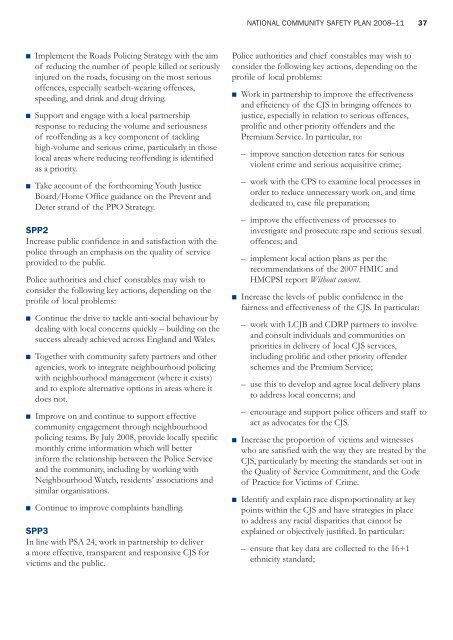nationalCommunitySafetyPlan200811 - Staffordshire County Council
nationalCommunitySafetyPlan200811 - Staffordshire County Council
nationalCommunitySafetyPlan200811 - Staffordshire County Council
You also want an ePaper? Increase the reach of your titles
YUMPU automatically turns print PDFs into web optimized ePapers that Google loves.
■ Implement the Roads Policing Strategy with the aim<br />
of reducing the number of people killed or seriously<br />
injured on the roads, focusing on the most serious<br />
offences, especially seatbelt-wearing offences,<br />
speeding, and drink and drug driving.<br />
■ Support and engage with a local partnership<br />
response to reducing the volume and seriousness<br />
of reoffending as a key component of tackling<br />
high-volume and serious crime, particularly in those<br />
local areas where reducing reoffending is identifi ed<br />
as a priority.<br />
■ Take account of the forthcoming Youth Justice<br />
Board/Home Offi ce guidance on the Prevent and<br />
Deter strand of the PPO Strategy.<br />
SPP2<br />
Increase public confi dence in and satisfaction with the<br />
police through an emphasis on the quality of service<br />
provided to the public.<br />
Police authorities and chief constables may wish to<br />
consider the following key actions, depending on the<br />
profi le of local problems:<br />
■ Continue the drive to tackle anti-social behaviour by<br />
dealing with local concerns quickly – building on the<br />
success already achieved across England and Wales.<br />
■ Together with community safety partners and other<br />
agencies, work to integrate neighbourhood policing<br />
with neighbourhood management (where it exists)<br />
and to explore alternative options in areas where it<br />
does not.<br />
■ Improve on and continue to support effective<br />
community engagement through neighbourhood<br />
policing teams. By July 2008, provide locally specifi c<br />
monthly crime information which will better<br />
inform the relationship between the Police Service<br />
and the community, including by working with<br />
Neighbourhood Watch, residents’ associations and<br />
similar organisations.<br />
■ Continue to improve complaints handling.<br />
SPP3<br />
In line with PSA 24, work in partnership to deliver<br />
a more effective, transparent and responsive CJS for<br />
victims and the public.<br />
NATIONAL COMMUNITY SAFETY PLAN 2008–11<br />
Police authorities and chief constables may wish to<br />
consider the following key actions, depending on the<br />
profi le of local problems:<br />
■ Work in partnership to improve the effectiveness<br />
and effi ciency of the CJS in bringing offences to<br />
justice, especially in relation to serious offences,<br />
prolifi c and other priority offenders and the<br />
Premium Service. In particular, to:<br />
– improve sanction detection rates for serious<br />
violent crime and serious acquisitive crime;<br />
– work with the CPS to examine local processes in<br />
order to reduce unnecessary work on, and time<br />
dedicated to, case fi le preparation;<br />
– improve the effectiveness of processes to<br />
investigate and prosecute rape and serious sexual<br />
offences; and<br />
– implement local action plans as per the<br />
recommendations of the 2007 HMIC and<br />
HMCPSI report Without consent.<br />
■ Increase the levels of public confi dence in the<br />
fairness and effectiveness of the CJS. In particular:<br />
– work with LCJB and CDRP partners to involve<br />
and consult individuals and communities on<br />
priorities in delivery of local CJS services,<br />
including prolifi c and other priority offender<br />
schemes and the Premium Service;<br />
– use this to develop and agree local delivery plans<br />
to address local concerns; and<br />
37<br />
– encourage and support police offi cers and staff to<br />
act as advocates for the CJS.<br />
■ Increase the proportion of victims and witnesses<br />
who are satisfi ed with the way they are treated by the<br />
CJS, particularly by meeting the standards set out in<br />
the Quality of Service Commitment, and the Code<br />
of Practice for Victims of Crime.<br />
■ Identify and explain race disproportionality at key<br />
points within the CJS and have strategies in place<br />
to address any racial disparities that cannot be<br />
explained or objectively justifi ed. In particular:<br />
– ensure that key data are collected to the 16+1<br />
ethnicity standard;

















